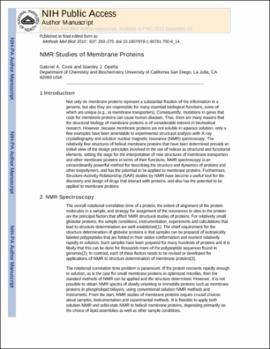| dc.contributor.author | Cook, Gabriel A. | |
| dc.contributor.author | Opella, Stanley J. | |
| dc.date.accessioned | 2023-10-30T16:36:02Z | |
| dc.date.available | 2023-10-30T16:36:02Z | |
| dc.date.issued | 2010-01-01 | |
| dc.identifier | oksd_cook_nmr_studies_of_membrane_2010 | |
| dc.identifier.citation | Cook, G.A., Opella, S.J. (2010). NMR studies of membrane proteins. 637, pp. 263-275. https://doi.org/10.1007/978-1-60761-700-6_14 | |
| dc.identifier.uri | https://hdl.handle.net/11244/339866 | |
| dc.description.abstract | Nuclear magnetic resonance studies of membrane proteins yield valuable insights into their structure and topology. For example, the tilt angle and rotation of the helices in an ion channel can be determined by solid-state NMR spectroscopy in aligned lipid bilayers. Details about the structure of the protein in aligned phospholipids environments are immediately apparent from inspection of the SAMMY spectrum and the data can be further used for the determination of atomic resolution three-dimensional structures. SAR by NMR is a technique that is well suited for the field of membrane transporter proteins. The experiments on protein/phospholipid samples provide a unique insight into the interaction of drugs and the functional proteins.The advances required to transform solid-state NMR from a spectroscopic technique to a generally applicable method for determining molecular structures included multiple-pulse sequences, double-resonance methods, and separated local field spectroscopy. It also required improvements in instrumentation, especially the use of high-field magnets and efficient probes capable of high-power radio-frequency irradiations at high frequencies. The pace of development is accelerating and the local field is being utilized in an increasing number of ways in spectroscopic investigations of molecular structure and dynamics. Applications to many helical membrane proteins are underway and promise to add to our understanding of membrane proteins in health and disease. | |
| dc.format | application/pdf | |
| dc.language | en_US | |
| dc.publisher | Springer Nature | |
| dc.relation.ispartof | Membrane Transporters in Drug Discovery and Development | |
| dc.relation.ispartofseries | Methods in Molecular Biology | |
| dc.relation.uri | https://www.ncbi.nlm.nih.gov/pubmed/20419440 | |
| dc.rights | This material has been previously published. In the Oklahoma State University Library's institutional repository this version is made available through the open access principles and the terms of agreement/consent between the author(s) and the publisher. The permission policy on the use, reproduction or distribution of the material falls under fair use for educational, scholarship, and research purposes. Contact Digital Resources and Discovery Services at lib-dls@okstate.edu or 405-744-9161 for further information. | |
| dc.subject.mesh | Membrane Proteins | |
| dc.subject.mesh | Models, Biological | |
| dc.subject.mesh | Nuclear Magnetic Resonance, Biomolecular | |
| dc.title | NMR studies of membrane proteins | |
| dc.date.updated | 2023-10-25T20:18:27Z | |
| dc.note | open access status: Green OA | |
| osu.filename | oksd_cook_nmr_studies_of_membrane_2010.pdf | |
| dc.identifier.doi | 10.1007/978-1-60761-700-6_14 | |
| dc.description.department | Chemistry | |
| dc.type.genre | Book chapter | |
| dc.type.material | Text | |
| dc.subject.keywords | biochemistry and cell biology | |
| dc.subject.keywords | chemical sciences | |
| dc.subject.keywords | biological sciences | |
| dc.subject.keywords | normal biological development and functioning | |
| dc.subject.keywords | underpinning research | |
| dc.subject.keywords | generic health relevance | |
| dc.subject.keywords | other chemical sciences | |
| dc.subject.keywords | biochemistry and cell biology | |
| dc.subject.keywords | developmental biology | |
| dc.subject.keywords | medicinal and biomolecular chemistry | |
| dc.identifier.author | ORCID: 0000-0002-3413-8361 (Cook, Gabriel A) | |
| dc.identifier.author | ScopusID: 57211689751 (Cook, Gabriel A) | |
